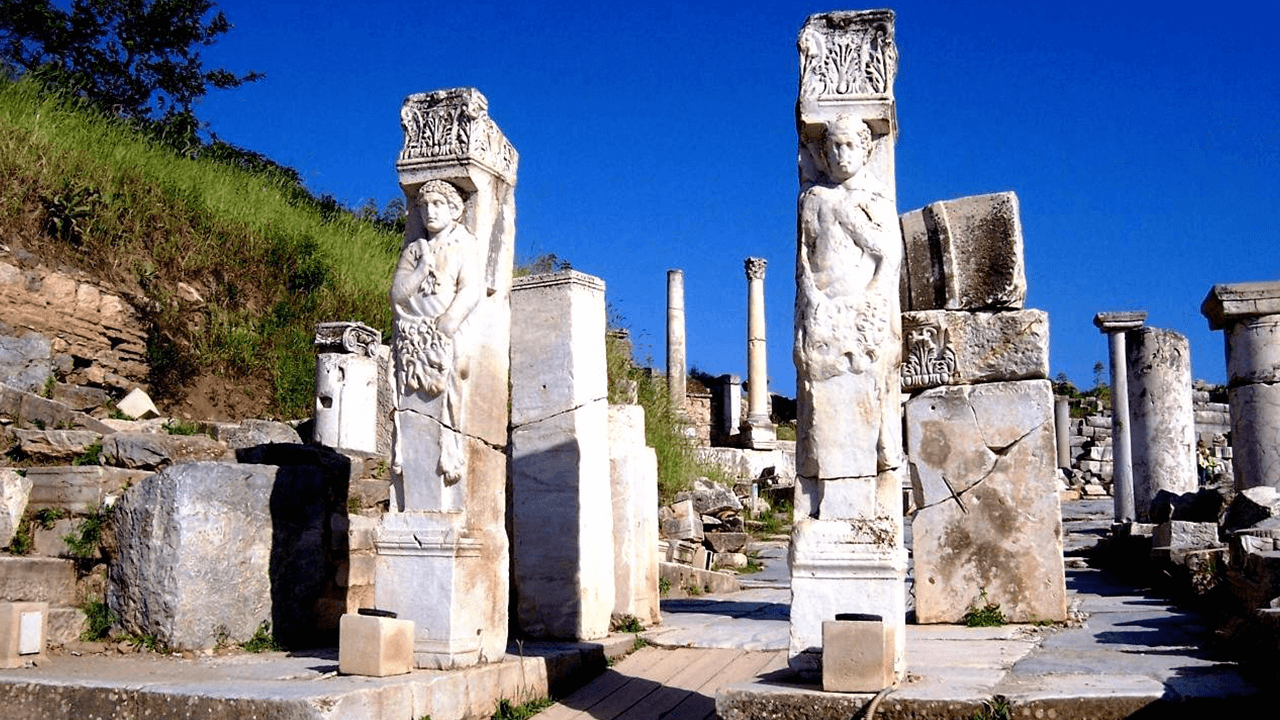Heracles Gate in Ephesus: A Mythological Icon at the End of Curetes Street
The Gate of Hercules, located at the end of Curetes Street in the ancient city of Ephesus, is one of the most iconic monuments of the city. Its name derives from the reliefs of Hercules, the Greek mythological hero, which adorn the columns that have survived through time. This gateway was moved to its current location in the 4th century AD, although its original reliefs date back to the 2nd century AD, making it a historic and artistic symbol of great importance.
History and Origin of the Gate of Hercules
The Gate of Hercules was relocated from another site in the 4th century AD, likely as part of an effort to beautify and reinforce the entrance to Curetes Street. While the original structure was more complete, only the sides of the columns remain today, allowing a glimpse of the magnificence of the design.
A Pedestrian Gateway on Curetes Street
The Gate of Hercules was designed to reduce vehicular access to Curetes Street, transforming this street into a pedestrian zone. This decision highlights the importance of the street as a meeting and transit space for citizens and pilgrims visiting Ephesus.
The Hercules Reliefs: Symbolism and Mythology
The reliefs decorating the gate depict Hercules wearing the skin of the Nemean lion, one of the most feared creatures in Greek mythology. According to myth, the Nemean lion terrorized the inhabitants of the region as its skin was so tough that no weapon could pierce it. Hercules, in his first labor, wrestled with the lion and defeated it by strangling it. This feat earned him fame as the strongest and most courageous hero, eventually deified as the god of power and strength.
The Skin of the Nemean Lion
In the iconography of the Gate of Hercules, the hero appears with the lion’s skin as a symbol of his victory over the beast. The skin became his emblem, symbolizing his invincible power and ability to overcome any obstacle. This representation at the gate allows visitors to connect with classical mythology and recall the heroic myths that influenced the culture of Ephesus.
Cultural and Touristic Importance of the Gate of Hercules
The Gate of Hercules is not only an architectural attraction but also symbolizes Ephesus’s connection with Greek mythology and tradition. This portal acts as a bridge between the past and present, reminding visitors of the stories and values that marked ancient Ephesus.
Transforming Curetes Street into a Pedestrian Zone
The conversion of Curetes Street into a pedestrian zone in the 4th century AD is an early example of urbanism and planning. This street became a safe area for pedestrian traffic, enhancing the walk to other key points in Ephesus and promoting social and commercial interaction.
Tips for Visiting the Gate of Hercules
- Location: The Gate of Hercules is located at the end of Curetes Street in ancient Ephesus. It is easily accessible, and stopping to appreciate the relief details is recommended.
- Best Time to Visit: It is advisable to visit the gate early in the morning or late in the afternoon to avoid peak heat hours and have better light conditions for photography.
- Respecting the Site: As a historical site, visitors are asked to respect the designated areas and avoid touching the structures.
Conclusion
The Gate of Hercules in Ephesus is a monument symbolizing bravery and power, embodied by the mythological hero Hercules. Its design and the reliefs adorning its columns reflect the rich cultural heritage of Ephesus and the importance of Greek myths in the lives of its inhabitants. By visiting the Gate of Hercules, tourists not only observe an example of classical art but also connect with the values of strength and perseverance represented in Hercules’s legacy. This historical site remains an essential stop for those seeking to explore the historical and mythological depth of the ancient city of Ephesus.


3 thoughts on “Heracles Gate”
★★★★★
Learning about and visiting ‘Heracles Gate’ was both fun and educational. Everyone should experience this!
★★★★★
My journey to ‘Heracles Gate’ was nothing short of amazing. A must-see for anyone exploring the area!
★★★★★
Every moment spent at ‘Heracles Gate’ was filled with wonder and learning. It’s a place I will always cherish.